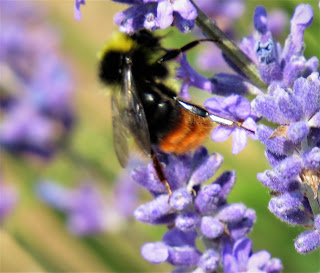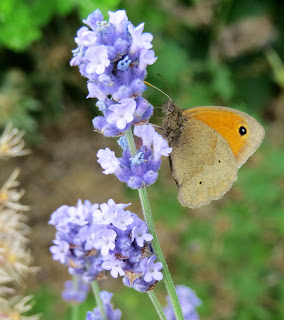 |
| Heacham Lavender |
Heacham is famous for it's lavender fields and gardens. At this time of year, the lavender is now in full bloom. It is the perfect time and place to celebrate Father's Day a day late. I wasn't able to celebrate it with my dad on the actual day as he was over in Wiltshire to see my brother and his family. So, while he is still on a week-long holiday, he has taken Mum and I to the lavender centre at Heacham to enjoy this purple display.
 |
| Dad about to enjoy a slice of lavender cake |
This is one of the few places in the UK that harvests lavender. They use it to make perfume, soap and even cake, scones and ice cream, which is sold in the café here. Lavender is a bit of an acquired taste. To me and Mum, it is like eating perfume and we don't enjoy it at all. For Dad, well, he seems to like it. So out of the three of us, he was the only one eating lavender cake and later, lavender ice cream. A late Father's Day treat.
 |
| White-tailed Bumblebee |
Of course, to say I was just here for the lavender would be a lie. I'm also here to try and find one of my targets, the wool-carder bee. This is a large black bee with yellow spots on the sides of it's abdomen. I've been told that they are common in gardens and places with lavender, so I thought what better place to see one than at Heacham. Unfortunately, though there were plenty of bees around, not a single one turned out to be the one I was after. It was also very hot today and we were soon finding it hard to walk around in the sun for very long. Sweat poured over my body, forming mini pools all over my forehead, which dripped down and into my eyes with the salt stinging them slightly. It was unbearable!
 |
| Early Bumblebee |
The weather may have caused me to suffer, but for the bees, they couldn't ask for anything better. The lavender was also driving them crazy. They loved the stuff. I have never seen so many species in one place in great numbers for a long time. As you may know, bees are having a tough time lately all over the world. Pesticides, diseases, not enough wildflower meadows and other factors have caused them to decline on a worrying scale. Bumblebees are suffering too and it would be sad to lose these black and yellow furry, flower-loving insects from our gardens and parks. But at least here they seem to be doing ok. I'm no expert, but I can tell that each species is quite distinctive from the other. I just hope I have identified them correctly.

 |
| Red-tailed Bumblebee |
 |
| Cuckoo Bumblebee (I think) |
 |
| White-tailed Bumblebee? |
 |
| Carder Bee |

 |
| Honey Bee |
 |
| Painted Lady |
As well as bees, there were plenty of other insects as well. The most notable were the butterflies. There were several small tortoiseshells, large whites, red admirals, a few meadow browns and the odd large skipper, but the real highlight was to finally see my first painted lady of the year. It is always a treat to spot one of these summer migrants. I also managed to spot a very pacey, large wasp that was moving around by my foot. I think it is one of the spider-hunting species on the prowl for it's next victim to hunt.
 |
| Small Tortoiseshell |
 |
| Meadow Brown |
 |
| Spider-hunting Wasp? |
 |
| Rosemary Beetle |
 |
| Green-bottle Fly |
 |
| Crane Fly |
 |
| Linnet |
 |
| Dryad's Saddle? |
 |
| Ringsted Downs |
After lunch and another quick search for a wool-carder bee, we made a short visit to Ringsted Downs. This is a pretty spot for a picnic and is one of the few chalk grasslands in Norfolk complete with its own chalk cliff. The wildflowers, especially the ox-eyed daisies and yellow loosestrifes, were in full bloom and I saw plenty of insects attracted to them, including this longhorn beetle.
 |
| Longhorn Beetle |
 |
| Yellow Loosestrife |


































Hi Sean. If you want to see Wool Carder Bee then I recommend going to Earlham Cemetery. There have been several on Lamb's ear plants (google it so you know what to look for, it looks like a sort of dead nettle covered in white hairs). These grow in a hedged-in area with the war graves, grid reference TG20800869.
ReplyDeleteThanks James. I shall have to try another day.
Delete